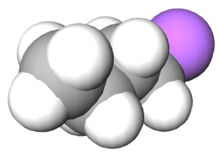Chemistry:N-Butylsodium

| |
| Names | |
|---|---|
| Preferred IUPAC name
Butylsodium | |
| Other names
1-Sodiobutane
| |
| Identifiers | |
3D model (JSmol)
|
|
| ChemSpider | |
PubChem CID
|
|
| |
| |
| Properties | |
| C4H9Na | |
| Molar mass | 80.106 g·mol−1 |
| Appearance | white solid[1] |
| Hazards | |
| GHS pictograms |  
|
| GHS Signal word | DANGER |
| Related compounds | |
Related compounds
|
n-Butylpotassium n-Butyllithium |
Except where otherwise noted, data are given for materials in their standard state (at 25 °C [77 °F], 100 kPa). | |
| Infobox references | |
n-Butylsodium CH3CH2CH2CH2Na is an organometallic compound with the idealized formula NaC4H9. Like other simple organosodium compounds, it is polymeric and highly basic.[2] In contrast to n-butyllithium, n-butylsodium is only of specialized academic interest.
Preparation
n-Butylsodium is prepared from n-butyllithium and t-butoxysodium.[2]
Properties
In n-Butylsodium, the Na-C bond has ionic character, with a negative charge on the end carbon atom. n-Butylsodium is insoluble in saturated hydrocarbons. It reacts with unsaturated hydrocarbons.[3] Soluble adducts are produced with Lewis bases such as tetramethylethylenediamine or tetrahydrofuran.[2]
Reactions
n-Butylsodium reacts with alkylbenzene or allylbenzene compounds to give new organosodium compounds. With toluene the major product is benzylsodium.[4]
n-Butylsodium reacts with 1-bromonaphthalene to make 1-sodiumnapthalene and 1-bromobutane,[5] but there are few such metathesis reactions.[6]
References
- ↑ Martinez-Martinez, A. J.; Kennedy, A. R.; Mulvey, R. E.; O'Hara, C. T. (13 November 2014). "Supplementary Material for Directed ortho-meta'- and meta-meta'-dimetalations: A template base approach to deprotonation". Science 346 (6211): 834–837. doi:10.1126/science.1259662. PMID 25395533. Bibcode: 2014Sci...346..834M. https://www.science.org/doi/10.1126/science.1259662.
- ↑ 2.0 2.1 2.2 Schade, Christian; Bauer, Walter; Von Ragué Schleyer, Paul (November 1985). "n-Butylsodium: The preparation, properties and NMR spectra of a hydrocarbon- and tetrahydrofuran-soluble reagent". Journal of Organometallic Chemistry 295 (3): c25–c28. doi:10.1016/0022-328X(85)80326-0.
- ↑ Coates, G. E. (2012) (in en). Principles of Organometallic Chemistry. Springer Science & Business Media. p. 50. ISBN 9789401096812. https://books.google.com/books?id=xqUyBwAAQBAJ&pg=PT50.
- ↑ Broaddus, C. D. (September 1966). "Metalation of Toluene. The Question of Kinetic vs. Thermodynamic Control". Journal of the American Chemical Society 88 (18): 4174–4178. doi:10.1021/ja00970a012.
- ↑ Gilman, Henry; Moore, Fred W.; Baine, Ogden (September 1941). "Secondary and Tertiary Alkyllithium Compounds and Some Interconversion Reactions with Them". Journal of the American Chemical Society 63 (9): 2479–2482. doi:10.1021/ja01854a046.
- ↑ Schlosser, M. (April 1964). "Organosodium and Organopotassium Compounds Part I: Properties and Reactions". Angewandte Chemie International Edition in English 3 (4): 287–306. doi:10.1002/anie.196402871. http://www.thevespiary.org/rhodium/Rhodium/Vespiary/talk/files/3260-Organosodium-and-Organopotassium-Compounds-Part-1-properties-and-reactions807f.pdf?topic=785.0.
 |

